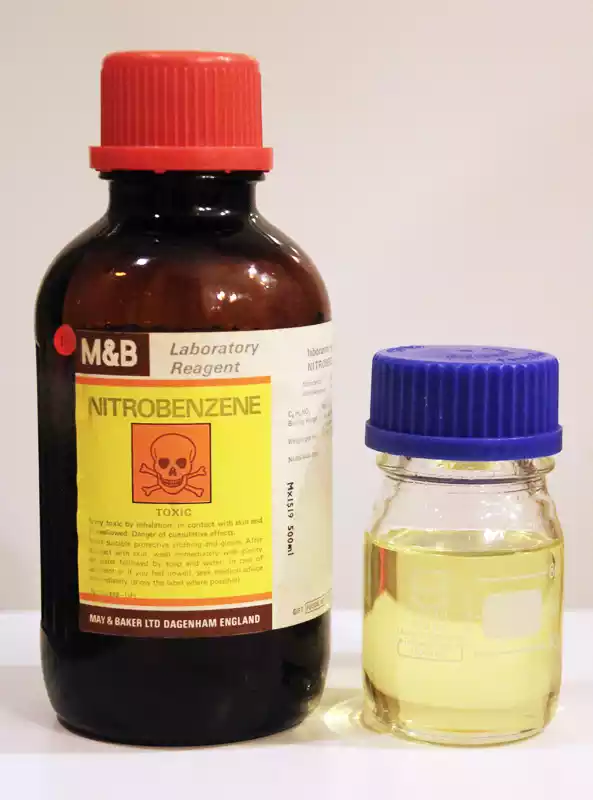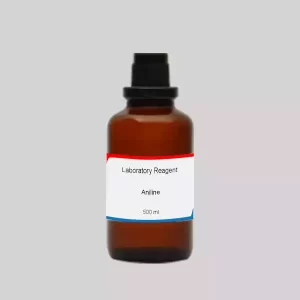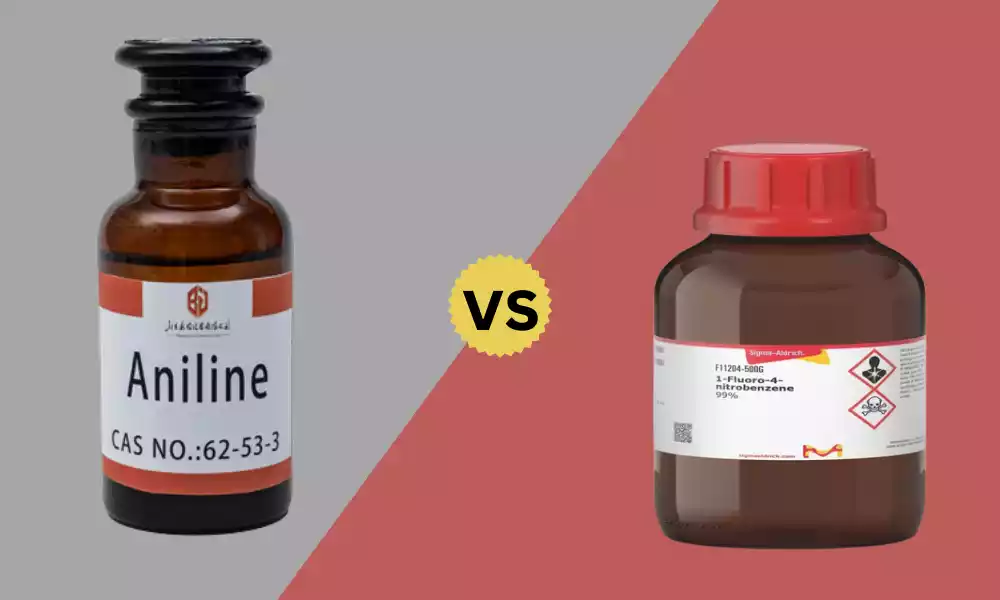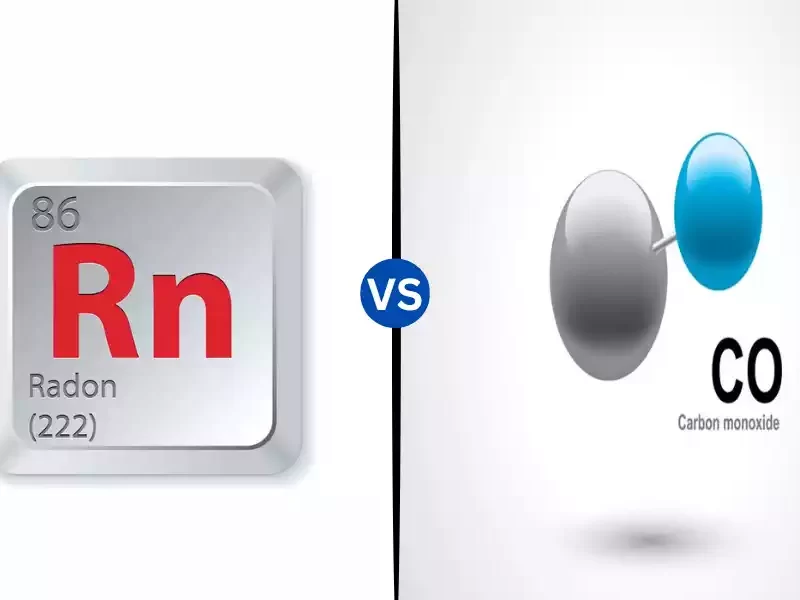Nitrobenzene and Aniline are two essential aromatic compounds that are renowned for their unique chemical structures and a variety of applications. Nitrobenzene is composed of a nitrogen group (-NO2) joined to a benzene ring while Aniline has one amino group (-NH2) linked to the rings of benzene.
These compounds have unique properties and play an important role in various industries, including dyes, pharmaceuticals, and manufacturing. Although they share the benzene ring as their foundation and functional groups, their distinct chemical and functional groups distinguish them, which affects their properties, reactivity, and possible impacts.
Examining the differences and characteristics in Nitrobenzene and Aniline exposes their unique importance in a variety of applications, and helps to understand their different applications in chemistry and industry.
What is Nitrobenzene?
It is an organic compound that has a chemical formula, of C6H5NO2. It is composed of a zincene ring (an aromatic ring with six carbons) with the nitrogen group (-NO2) that is attached to it. The molecular structure of nitrobenzene is an atom of nitrogen that is linked by two oxygen atoms (in the nitrogen category) which is known as a substance.

It’s a pale yellow oily liquid that has an unusual, slightly sweet scent. Nitrobenzene is produced industrially through the nitration of benzene by an encapsulated sulfuric acid as well as nitric acid. The process replaces one of the hydrogen atoms within the benzene rings with a nitrogen group.
Nitrobenzene is used in a variety of industries, such as the manufacture of aniline which is the primary ingredient in the production of pharmaceuticals, dyes, pesticides, rubber chemicals, and even synthetic rubber. It also serves as a solvent for various chemical reactions as well as a precursor to organic chemical synthesis.
It is important to be aware that nitrobenzene is poisonous and exposure to high levels can harm the health of humans. Therefore, safe handling and safety measures are vital when working with this chemical.
What is Aniline?
Aniline is one type of chemical that is employed in many industries. It’s a clear, to somewhat yellow liquid that has a distinct scent, and it could also be solid in its purest form. Aniline is part of a class of chemical compounds known as aromatic amines.

It is made by processes that involve the molecule nitrobenzene. It is transformed into aniline via the chemical reaction known as reduction. The reduction process transforms the nitrogen groups (-NO2) found in the nitrobenzene to the amino group (-NH2) which results in the formation of aniline.
Aniline has numerous uses. It’s an important ingredient in the manufacture of dyes that are used to color plastics, fabrics, and leather. It is used in making various kinds of rubber, medicine as well as agricultural chemicals. It is also used in the production of specific plastics.
While aniline can be used for a variety of purposes, however, it’s important to be handled carefully as exposure to large quantities of aniline may be harmful to your health. Security measures must be adhered to in the handling of aniline in order to minimize any risk to health.
Key Difference Between Nitrobenzene and Aniline
Here’s a comparison chart highlighting the key differences between Nitrobenzene and Aniline:
| Characteristics | Nitrobenzene | Aniline |
|---|---|---|
| Chemical Structure | Benzene ring with a nitro group (-NO2) | Benzene ring with an amino group (-NH2) |
| Physical Appearance | Pale yellow liquid | Colorless to pale yellow liquid or solid |
| Odor | Sweet, almond-like | Aromatic, fishy |
| Melting Point | Solidifies at 5.7°C | Solidifies at -6.0°C |
| Boiling Point | Boils at 210.9°C | Boils at 184.1°C |
| Solubility in Water | Moderately soluble | Moderately soluble |
| Main Uses | Precursor in aniline production, dyes, solvents, organic syntheses | Dye production, rubber chemicals, pharmaceuticals, polyurethanes |
| Toxicity | Considered toxic | Can be harmful upon exposure to high concentrations |
| Safety Precautions | Requires careful handling | Demands cautious handling to prevent health risks |
Chemical Structures of Nitrobenzene and Aniline
Nitrobenzene: Nitrobenzene is a molecular structure where the nitrogen groups (-NO2) is joined to a benzene-benzene circle. The chemical formula for Nitrobenzene is C6H5NO2. The benzene ring is composed of six carbon atoms that are arranged in a hexagonal ring that has multiple double and single bonds and also has a nitrogen group (-NO2) that is attached to one carbon atom within the ring. The nitro group comprises the nitrogen atom (N) that is double-bonded by two oxygen atoms (O) and one connection to the ring.
Aniline: Aniline’s chemical structure has an amino group (-NH2) joined to a ring of benzene. The chemical formula of Aniline can be found as C6H5NH2. Like Nitrobenzene, Aniline also has a benzene ring that has six carbon atoms, forming the hexagonal ring, which has double and single bonds.
Instead of a nitro group, Aniline is the amino group (-NH2) that is attached to the benzene rings. The amino group is composed of a nitrogen atom (N) joined by two hydrogen molecules (H) and is bonded to the benzene rings.
Properties of Nitrobenzene and Aniline
Nitrobenzene A pale yellow liquid, has an almond-like scent that is sweet and has a density of around 1.20 grams per cubic centimeter. It solidifies around 5.7 temperatures Celsius and then evaporates at 210.9 degrees Celsius. It has moderate solubility when dissolved in water.
The structure of Nitrobenzene comprises a benzene-based ring with a nitrogen group (-NO2) attached, which makes it able to undergo reduction reactions that result in other compounds such as aniline. Its toxicity is well-known when exposed to high levels can cause harmful health consequences, which highlights the importance of taking care when dealing with this chemical.
Aniline appears as a pale yellow to colorless liquid that is a solid at lower temperatures, with a distinctively aromatic and fishy scent. Its density is approximately 1.02 g/cm3, forming a solid when temperatures drop below -6.0 temperatures Celsius and then evaporates at 184.1 degrees Celsius and has the same moderate solubility in water as Nitrobenzene. +
In terms of structure, Aniline is a benzene ring that has an amino group (-NH2) that is attached, contributing to its reactivity when it comes to producing pharmaceuticals, dyes, and other compounds. Just like Nitrobenzene Aniline can also be dangerous when exposed to high levels, requiring cautious handling to avoid health problems.
What are the uses of Nitrobenzene?
The use of Nitrobenzene is diverse across diverse industries:
- Manufacturing of Aniline: One of the main uses for the nitrobenzene precursor is to the production process of aniline. Through a reduction process, the nitrobenzene becomes aniline, an essential chemical that is used to make diverse chemicals, such as dyes, pharmaceuticals, as well as rubber chemicals.
- Dye Production: Nitrobenzene is an ingredient in the creation of dyes. Aniline, which is derived from nitrobenzene is an essential component in the production of many dyes that are used in the leather and textile industries to color fabrics as well as leather products and various other materials.
- Solvent: The solvent is utilized in a variety of processes and reactions. Its properties as a solvent help in dissolving, and also facilitating reactions to produce specific chemicals and compounds.
- Organic Synthesis: Organic Chemistry The nitrobenzene compound is utilized as a base material or as an intermediate for the creation process of different organic chemicals, pharmaceuticals, and agricultural chemicals.
- Polymers and Explosives: Nitrobenzene can also be used in the manufacturing of explosives, including certain kinds of explosives and propellants. In addition, it plays an important role in the manufacture of certain plastics and polymers.
What are the uses of Aniline?
Aniline has many important applications in various industries:
- Dye Production: Aniline is a vital ingredient in the production of dyes. It acts as a precursor to make a variety of dyes in leather, textiles plastics, and various other materials. Aniline-based dyes are available in a broad variety of colors. They are also widely utilized within the industry of textiles to dye fabrics.
- Rubber Chemicals: Aniline is used in the manufacturing of accelerators and rubber chemicals and accelerators, which contribute to the manufacturing of rubber-based products such as belts, tires shoes, hoses, and belts.
- Pharmaceuticals: The aniline is an element in the synthesis of diverse pharmaceutical intermediates and pharmaceuticals. Aniline derivatives are employed in the manufacture of drugs including analgesics as well as antibiotics.
- Production of Polyurethane: Aniline is the most important ingredient in the production of polyurethane. It is used for the manufacture of coatings, foams, sealants, adhesives, and a variety of other plastics.
- Pesticides and Herbicides: Aniline derivatives are employed in the manufacturing of pesticides and herbicides used in agriculture to guard crops from pests and weeds.
- Photographic Chemicals: Aniline derivatives can be utilized to make certain chemicals that are utilized in photographic processes.
What safety precautions should be taken when handling Nitrobenzene and Aniline?
Here are some crucial precautions to be taken:
- Use protective equipment: Wear appropriate personal protective equipment (PPE) like gloves, safety glasses lab coats, lab coats, or other protective clothing to avoid contact with skin and protect eyes from exposure to fumes or splashes.
- Ventilation: You should work in a properly ventilated space or use fume hoods in order to reduce exposure to gases, vapors, or aerosols. The chemicals must be treated in a controlled atmosphere that has appropriate ventilation systems.
- Avoid ingestion and breathing: Avoid eating, smoking, drinking, ing, or applying cosmetics to the areas where chemicals are being handled. Avoid breathing in fumes or vapors with the use of respirators in the event of need.
- Storage and handling: Storage and Handling: In properly labeled, securely sealed containers that are cool, well-ventilated, and dry area, away from potentially incompatible substances. Be sure to follow the proper handling guidelines as outlined in Material Safety Data Sheets (MSDS) or Safety Data Sheets (SDS).
- Avoid contact with the skin: Prevent skin contact by wearing protective gloves and clothing. If there is an accident involving contact with skin, wash the affected area immediately using soapy water. Contact a doctor if you notice the skin is irritated or if adverse reactions develop.
- Cleaning up spills and leaks: In the event of spills or leaks, keep the space and clean it promptly with absorbent material. Avoid contact with direct objects and wear protective gear when cleaning. Remove contaminated substances in accordance with local regulations.
- Emergencies: Be familiar with emergency procedures for spills, accidents, leaks or exposure. Give training to employees in handling emergencies, and using safety equipment such as eyewash stations as well as emergency showers.
- Health Monitoring: Conduct regular monitoring of health for those working with these chemicals in order to identify and address any health concerns that may arise from exposure.
Ending
Nitrobenzene is a light yellow liquid that has a sweet scent, which is used mainly to make aniline as well as solvents, dyes as well as in organic syntheses. It’s toxic and requires care when handling.
Aniline, which is a colorless to mild yellow liquid plays a vital role in the production of dyes and rubber chemicals, pharmaceuticals, and much more. It requires careful handling because of the potential health hazards. Both chemicals are essential in a variety of industries and require security precautions when used to reduce health risks.



